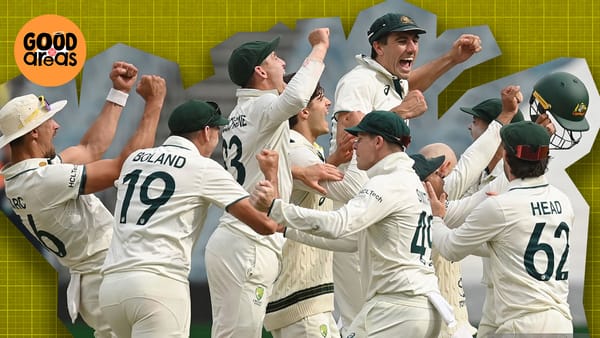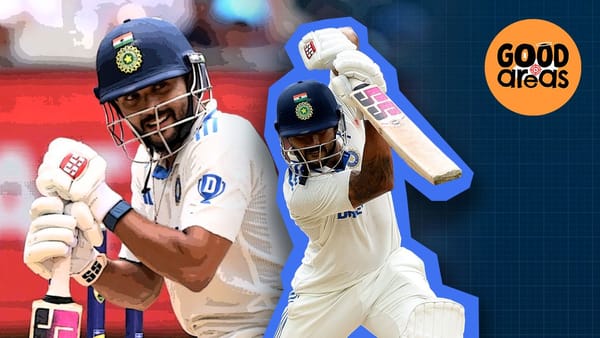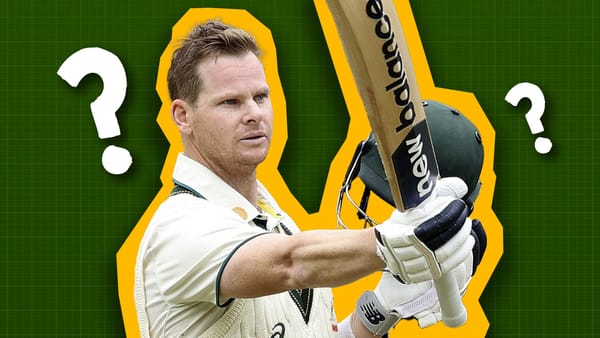What if we made Don Bradman time travel?
I was asked a question recently about how the GOAT would bat if you took him from his period and dropped him in ours.
This is about Don Bradman, but to get to him, you need to start with his era. And if he was the best batter in his time, then Clarrie Grimmett was the best bowler.
Grimmett took 216 wickets in 37 Tests at an average of 24. He did all of that with a hat on, and he was the fastest to get to that mark for a long time until another leg spinner - Yasir Shah - went past him. So he held the record for the quickest to get them for 82 Years. Or, to be precise, 30,243 days.
On top of that, he was the first man to get 200 Test wickets. And he also held the mark for most wickets for 19 years. Though it was war assisted.
I could go on with Grimmett facts forever, so I will. He bowled the most deliveries per game of any bowler ever. And it's not close. He averaged 65 six ball overs per match.
And as good as he was 33 when he made his Test debut. He was born in Dunedin and played cricket for Wellington, before New Zealand were a Test team. So he came to Sydney, and dominated, but NSW didn't want him. So he went to Melbourne, and dominated, and they didn't want him. So he went to Adelaide and finally got a shot. Moving locations three times when cricket was amateur is no joke. And if he hadn't, we'd probably never had the flipper, which he invented.
By today's standards Grimmett was slow, awkward and looks as threatening as a glass of milk. And sure, looks can be deceiving, but for a long period Grimmett was one of the best bowlers in the world, with a cap on, and at the same time, Don Bradman was the best batter in the world.
And statistically, he still is. There has never been a player even slightly like him. We've had flare-ups, and great runs, but Bradman's numbers still look like they come from his personal dreams. 3094 Test players have been around, many of them batters.
In fact, there are 327 Players with more than 2000 Tests runs. That is a lot of people, most of which made it because of their batting talent. And there are no bad players here. Sure, a couple of bowlers slipped in, and there's no doubt some guys were given incredible goes by selectors. But to make 2000 test runs is something special, and Bradman is laughing at these guys.

You often get people say the game was easier back then, that is true. But why didn't everyone else average a hundred ?In fact, why couldn't anyone else even average 70?
But it was a different time, There were only two top teams in Bradman's era, and he didn't have to face Grimmett, Lindwall, Miller and O'Reilly because they were on his side (Although he did face them in first class cricket, and smacked them). India and New Zealand were really struggling in his era. West Indies and South Africa were slightly better. But it was England who had a professional setup for a hundred years before Bradman who he still managed to average almost 90 against.
And yes, Australia is historically a great place to bat. Bradman was pretty good at home, but he averaged more away. And by that, I mean England, because that is the only place he ever batted in a Test outside home. There are no holes in this resume, even when noting how limited his experience would be compared to a modern player with 52 Tests.
And the only way to really compare players is to show us how good someone was versus their contemporaries. The game changes so much even during eras that comparing a player to the era they played is a far better method than anything else.
We know that overall the standard of cricket gets better. Through improved coaching, playing professionally, analysis, physios, video, diets, medical help and everything else. Athletes are taller, faster, and stronger. That doesn't mean all players, but the average.
So if you say, as I did once, that if Viv Richards played T20 we'd expect him to average 40 with a strike rate of 160. I don't mean that if you kidnapped Viv and brought him forward in a time machine he'd make those numbers.
I am saying that if you transplanted his numbers to current day, that's what they'd look like. I am basing that on him versus not only the ODI players of his era, but even the next few. Look how long it took players to catch up to how he hit the ball.

Viv clearly was ahead of his time, but even then, players did catch up. No one has caught up to Bradman. His name basically means a pinnacle that can't be scaled.
But his actual time was so long ago. And so much has changed. Recently someone asked me on Wagon Wheel how about Bradman would go in modern cricket.
I think we know that many great players they would have transferred their games over to modern cricket if they were born in this era. Had they access to the same professional setups and development. Bradman certainly believed he could transcend eras, when asked what he would average against the great West Indies, he said 50. When people were shocked it was that low, he pointed out he was in his 80s at the time.
But what if we just kidnapped Don Bradman as he was making his debut and landed him in modern cricket.
As we showed with Grimmett before, the game Bradman dominated no longer exists. It has morphed almost beyond recognition from his game. So let's look at the bigger challenges for our time travelling Bradman.
Harder wickets
Even well after he retired, there were still uncovered wickets in Tests. It took generations for cricket to cover the square. And uncovered pitches get a bad run these days, but some of the flattest batting wickets I ever played on were uncovered. They were tough after rain, and even Bradman was said to have hated those kinds of wickets. So as pitches got flatter, faster and harder, I think this is one thing he would really like about the modern era.
Wobble ball
It's been 0 days since I last mentioned the wobble ball. I find this one interesting because there was more seam movement on the Bradman-era wickets than today. And he dominated that. The wobble ball takes away his one big advantage, though. His super skill was reading the bowler. The wobble ball makes that very tough. I would say the closest modern batter to him in terms of style is Steve Smith, who has struggled with it.
Reverse swing
This feels like less of an issue as teams are trying to keep the ball seaming as long as possible and with the lack of saliva, are struggling to get much reverse anyway. Bradman played across the line, so he would be attacked with reverse swing. But if we were talking about the pre-sandpaper era I think he would struggle more. I don't think this would bother him now that it's happening less.
LBW
He did play across the line, and in his era LBWs were in favour of the batters in terms of umpires believing everything was sliding down leg. That's no longer the case. I think that would bother him.
Data analysis
We just don't know that much about his game, the most advanced things we can look as it stands is him in each nation. But we can't break him down by types of bowlers, although Charles Davis may work on something like that into the future by studying his old scorecards. But we have no pitch maps or shot data on him. If he played now, we'd know everything. And he'd be tested in ways that were impossible in his time.
Video analysis
We know that analysis could slow Bradman down because over 65 years before video analysis was a thing England tried it on Bradman. They watched him bat on film in a smoke-filled Lord's committee room until Douglas Jardine saw Bradman flinch at a short ball. Jardine backed this up with other research on Bradman and also a new leg theory that had been used by West Indians and in county cricket. Think of all the work Jardine had to put in to work this out. Stokes could he half hungover on a sleep-in, roll over and see any delivery time travel Bradman ever faced on his phone.
Bouncers
And what ball did Bradman flinch at, the bouncer. So let's get the obvious out the way. He'd have to get used to batting with a helmet, and maybe chest or arm guards as well. Remember, England had one summer of short stuff and Bradman never had to face that again. Now we bounce tailenders like that. What would Bradman do when facing Neil Wagner, who was quicker than Bill Voce, was more accurate with his bouncer and could deliver it for longer.
Southpaw seam
This is Voce bowling. Remember at this point, left-arm seam was very rare. You can also see an odd field with more players behind square on the leg side. But, you know, this isn't Mitchell Johnson, is it. To Bradman, Voce would have been a challenge.
In repsent day, Bradman would have to face Wagner and Boult together if he played New Zealand. Bradman was bounced, but nothing like we do now. There is no way a young player not used to that could work this out straight away.
Faster bowlers
And the bowlers are faster. Let's be friendly to Harold Larwood, saying he topped out at 85MPH. That makes him a medium-fast bowler by today's standards. And Larwood was a proper quick in his era. Modern bowlers have slower balls faster than the speediest ball of most bowlers in Bradman's era. The pace of modern bowlers is undeniable. And it's not just pace. Quick bowlers are becoming more accurate. Pat Cummins was yards faster than Larwood, more accurate, more skilful, and taller.
Taller bowlers
The last bit is perhaps the most crucial; bowlers have become really tall. Bradman-era bowlers were not. That is because of a law change where we now look at the front foot for the no ball and not the back. That changed us from a slingier swing style to a taller hit-the-seam method.
Kyle Jamieson is a foot taller than Larwood. Bowlers have been growing and growing. Joel Garner was seen as a monster, off the top of my head, there's two Jansen's, Kyle, whatever happened to Mohammad Irfan, my last dying hope for a billy Stanlake and Scotland's Adrian Neil all at or above Garner.
The current four quicks for Australia are all well comfortably above six foot. Larwood is a jockey compared to them. Now, I am mentioning Harwood a lot, but his bowling partner Bill Voce was called tall at the time. According to David Frith's Bodyline Autopsy, Voce is six foot three. We wouldn't even consider that a tall bowler these days unless he had a huge wingspan and we can measure his high release. We'd think that was a pretty normal height for a bowler now.
Things have changed. Playing a back-of-length ball from 6 foot 3 is not like one at six eight.
But we talked about how Bradman averaged 102 in England earlier on, and how remarkable that was, what we didn't mention was that he averaged 0 in New Zealand, India, South Africa and the West Indies. Now that's obviously because he never played in any of those places for Tests or first class.
That can't happen anymore. Bradman would have to play in more locations. And while there are questions on how he would have handled many different conditions now, the obvious ones are Asia. If Bradman had played there in his time he would have been fine, as the cricketers weren't good enough to challenge him. But now, it's a whole different world.
Asia
We know traditionally, Australians would prefer not to bat in Asia, and Bradman would have been the same. Though this is the one place, his skills on uncovered decks would have been handy. And if you look at Steve Smith, he has played 18 Tests in Asia, the most of any content outside Australia.
If you look at Steve Smith, you will see he plays in Asia the second most of any continent. That means that Bradman would have to learn how to play in Asia, even to a basic level. And while he played a lot of spin in his time, and some great bowlers like Hedley Verity. We know that playing spin in Asia is altogether different. How would he do on fast-spinning Indian tracks, low-bouncing UAE wickets, or ragging in Sri Lankan decks? These are hard to prepare for when it comes to modern players, a time-travelling Bradman would struggle.
Spin
But spin has also changed. As you saw with Grimmett before, it was slower. Even Tiger Bill O'Reilly who was quick for him, was nowhere near the pace of Rashid Khan, Axar Patel or Ravi Jadeja. And all those bowlers have DRS as well. So playing them from the crease on helpful surfaces is so hard. And coming down the wicket is tough because they are so quick. We have already seen players like Smith and Kevin Pietersen struggle with the ball turning away at times in the DRS era because they play across the line, well so did Bradman.
I don't think he'd be able to get to the pitch of many spinners, but if you look at the footage of him to spin, he usually played back, and only occasionally used his feet. His game was similar to Joe Root, without the sweep. Deep or forward connection points. And while he didn't sweep as much, he could. Being so small, he banked on bowlers slightly missing their lengths to pull. I think he'd sweep more than pull now, but it's not as big an adjustment as to seam. But Bradman had none of those before playing on Asian decks, to quicker bowlers, with DRS.
It's not that our time lord Bradman would suddenly lose his skills, ihe didn't dominate by accident. And he really built modern batting. He was every bit as good as his average suggests and he moved batting forward by being great. But everything that cricket in the 1920s and 30s trained him for wouldn't be of much use to a lightning-quick Rashid Khan wrong'un, Jasprit Bumrah's Surprise pace and Kyle Jamieson's massive reach.
Whereas Grimmet was slow, awkward and looks as threatening as a glass of milk. Jadeja is a world-class athlete and quick-spinning super predator.
Cricket has evolved, and Bradman helped do that.




